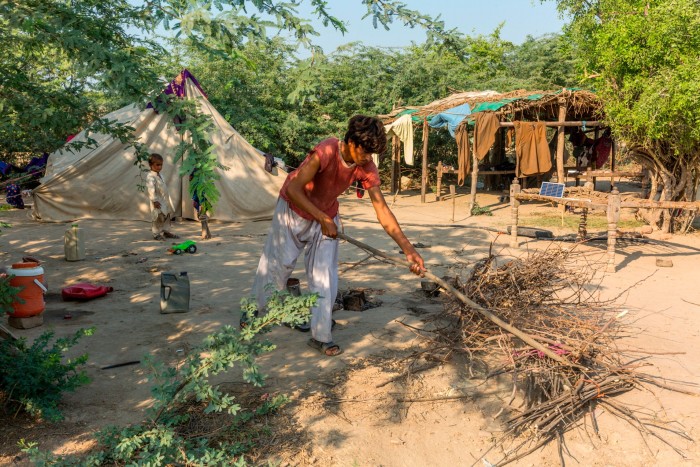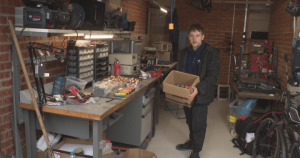Floods recovery ‘test case’ leaves millions still in tents

Pakistan is a disappointing test case for global financial co-operation aimed at helping countries after extreme climate events, local and international officials say, as 12mn victims languish in tents and makeshift huts after devastating floods two years ago.
The amount initially pledged to support the recovery was more than $10bn, coming from wealthy countries, the World Bank and multilateral development banks, out of the estimated $16.3bn needed in total.
But government and international development officials in Pakistan say that the cash-strapped country of 240mn has since been short-changed by the international community.
Those who survived the floods which affected some 33mn people in 2022 and swept away 2.5mn houses are now living at the mercy of the forces that already drove them from their homes once.
This year, heavy rains during the monsoon season killed another 300 people and damaged at least 20,000 houses, according to Pakistan’s disaster response agency.
Climate change contributed to up to 50 per cent of the rains behind the 2022 floods, according to a study by the World Weather Attribution group.
Sindh province, where the financial hub of Karachi is located, was among the hardest hit. It is also one of the world’s hottest places — this summer temperatures topped 50C in some cities, causing the death of hundreds of labourers who toil outside.
“Delays in the release of funds and the implementation of projects have hindered Pakistan’s recovery efforts and left millions of people, particularly in Sindh and Balochistan, vulnerable,” Aisha Moriani, a senior official at Pakistan’s climate change ministry, told the Financial Times. “Time is running out to protect millions of vulnerable citizens from another disaster.”
Some $3bn has been disbursed, according to Pakistan’s economic affairs ministry, but almost all of that is in the form of dollar-denominated loans that were repurposed from pre-existing projects in Pakistan. This has added to the country’s mounting debt burdens, analysts and government officials say.
Typically, the majority of the money pledged in assistance to needy nations comes in the form of more high-interest debt rather via grants, with developing nations pushing for reform of the World Bank and IMF systems at meetings this week.

The officials and aid workers on the ground in Sindh are racing before another disaster strikes to use the money that has been freed up to reconstruct more than 2mn homes in what they say is the one of the world’s largest-ever housing rehabilitation projects.
Sindh People’s Housing for Flood Affectees, a non-profit company launched by the provincial government armed with some $2bn, mostly from the World Bank and other development lenders, has already built 200,000 brick-and-cement homes with another 700,000 still under construction, sturdier replacements for the traditional mud-and-thatch huts.
SPHF and the Sindh government faced a slow start, as they wrangled with cautious development banks, risk-shy local banks and feudal landlords to secure project funding, open bank accounts for flood survivors, and provide formal land titles or tenancy agreements to allow victims, many of whom work as peasants, the right to build a home.
Khalid Sheikh Mehmood, the chief executive of SPHF, expects that his organisation will be able to complete all their reconstruction by 2026 and that the project will pay for itself threefold.
“You’re giving someone a new house that doesn’t fall in heavy rains, a house they can protect their livestock, their asset, in, and a sense of empowerment,” he said. “That $2bn will easily turn into $7bn of value.”
But he also said that simply rebuilding housing was not enough for Pakistan to recover from the destruction. His team will attend the upcoming UN COP29 climate summit in Baku to request another $4bn to build drainage and other infrastructure needed to survive heavy rains and flooding.
“We’ve shown we can put money to good use, to build things, so we hope the international community can have faith to let us show what else we can do.”


The next round of reconstruction will also be pricier, as inflation — which rose to as high as 38 per cent last year before falling to about 6.9 per cent last month — and the surge in demand for wood, cement and construction experts has caused the cost of both materials and labour to rocket.
Javed Iqbal, humanitarian co-ordinator for Islamic Relief, another organisation rebuilding homes in Sindh, estimates that the cost of bricks for a single house that his organisation builds in Mirpur Khas district has risen by at least 55 per cent in the last year. “I’ve had to request a bigger budget to keep up and finish things on time,” he said.
Popat, who like many Sindhis goes only by his first name, received about Rs300,000 ($1,080) from SPHF, but said he had to sell all of his goats and seek loans from family members to raise the extra Rs100,000 ($360) equivalent to about 10 months’ salary, to complete his new home in a village in Tando Allahyar district.
Qaiser Bhil, a community organiser in the village, said that half of the flood-affected residents had not been so lucky, as a combination of disbursement delays and rising prices had kept others without a reliable roof over their heads.
“Every time the monsoon comes in, we get very scared and anxious,” she said. “[The village] needs the money to come quickly.”

The massive cost of rebuilding has put further strain on Pakistan’s already limited finances, and officials and economic analysts have advocated that the debt-wracked country receive some relief from its obligations as it recovers.
Sherry Rehman, who served as Pakistan’s climate change minister during the 2022 floods, told the FT that Pakistan was trapped in a “recovery trap” as it takes on debt and diverts much-needed development spending to pay for climate disasters.
“We’re piling on the debt, just to put people back on their feet, just a little above subsistence level, from a disaster we didn’t cause,” she said.
“But every summer brings different scales of disaster, with floods and heatwaves ravaging the country, destroying crops and livelihoods, forcing us to spend more to stay afloat.”
Officials in Sindh say the flood reconstruction work still eats up the majority of the province’s development budget, as money intended to construct new schools, train teachers or build paved roads is instead siphoned towards rebuilding the infrastructure and houses destroyed two years ago.
“We are trading away our future to repair from the disasters of the past,” one provincial official said, estimating that Sindh still faces an $8bn shortfall in funding to rebuild everything damaged in the floods.

A key figure in climate finance, Avinash Persaud, special adviser on climate change to the president of the Inter-American Development Bank, said Pakistan’s experience was not unusual for countries in its position.
“As often happens that money doesn’t materialise or it is highly conditional. The conditions aren’t able to be reached; they are not practical.
“It is a real problem when so much of loss and damage after a flood is not money you can recoup. You are rebuilding homes that have been washed away, schools and clinics that have been washed away. If nations have to do that every time they will sink on the oceans of debt before the sea levels rise up themselves. That is why we do need it to be grant-based.
“The reality is what happened in Pakistan is not unusual. When people said this would be a test case [for loss and damage], what they were sort of saying was this can’t be a repeat of what normally happens. We need to show this is different. But unfortunately it wasn’t different.”
For former Pakistan climate minister Rehman, there is a stark message for the other vulnerable nations, particularly those near the equator, who are not climate resilient.
“In a word, I’m disappointed. If there is a lesson in all this, it’s fend for yourselves.”
Climate Capital

Where climate change meets business, markets and politics. Explore the FT’s coverage here.
Are you curious about the FT’s environmental sustainability commitments? Find out more about our science-based targets here
#Floods #recovery #test #case #leaves #millions #tents




